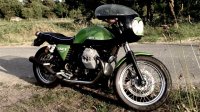timothy st.john
Cruisin' Guzzisti
Hello everyone,
Has anyone experimented with aftermarket trumpet-type horns, electronic or air driven? Someone tried to occupy my lane yesterday, and simply wouldn't or couldn't obey the authority of my beep-beep OEM horn. Interestingly, the same selfish driver tried to do it again to someone else, only seconds later in a continued effort to move right, but was stopped by a quick blast from a conventional car horn; ironically, it was a new Volkswagon beetle.
There are several electronic trumpet style horns that issue significantly louder warnings. Despite what the independent reviewers claim, the numbers they record on their dB meters register significant improvement.While none of them seem to deliver the promise their manufacturers claim for them, in terms of electronic registration on a meter, they are almost always twice as loud, and invariably more authoritative in pitch.
Part of the problem is that the reviewers don't understand acoustics, and so they often place their meter too close to the source. The other thing is that they fail to believe their ears, which tell a different story to the meter. Failing to recognize that other motorists are using ears, and not dB meters to register the physical and psychological effect of these horns is the greater sin.
As far as dB's are concerned, know that and increase of 10 dB is perceived as a doubling in volume, while a single dB is a simply a unit of measurement that denotes the smallest incremental change in the perceived volume of a sound source. That is to say, if you very slowly turn up the volume on a device until a listener finally declares that they can tell that the sound level has increased, it is said to have gone up 1 dB.
So, a horn that is 10 dB louder is perceived as being twice as loud. That's significant! However, it is the manipulation of the tenor (the quality of the sound) and its tessitura (pitch) that register or declares itself more or less aggressively on our conscious and unconscious accounting of a situation. The beep-beep style OEM horns are actually quite loud, they just have no authority in the constellation of our concerns.
There are electric horns that are direct replacements for the OEM ones, that give you bike the aural authority of a car, without need of any extra consideration. Simply plug them in and go. Hella, Wolo, PIAA, and others make small inexpensive non-compressor/air horns types that seem a much better option when it comes to barking in advance of the bite of collision. What is your experience, and what if anything have you undertaken to do about it.
Timothy St. John
Has anyone experimented with aftermarket trumpet-type horns, electronic or air driven? Someone tried to occupy my lane yesterday, and simply wouldn't or couldn't obey the authority of my beep-beep OEM horn. Interestingly, the same selfish driver tried to do it again to someone else, only seconds later in a continued effort to move right, but was stopped by a quick blast from a conventional car horn; ironically, it was a new Volkswagon beetle.
There are several electronic trumpet style horns that issue significantly louder warnings. Despite what the independent reviewers claim, the numbers they record on their dB meters register significant improvement.While none of them seem to deliver the promise their manufacturers claim for them, in terms of electronic registration on a meter, they are almost always twice as loud, and invariably more authoritative in pitch.
Part of the problem is that the reviewers don't understand acoustics, and so they often place their meter too close to the source. The other thing is that they fail to believe their ears, which tell a different story to the meter. Failing to recognize that other motorists are using ears, and not dB meters to register the physical and psychological effect of these horns is the greater sin.
As far as dB's are concerned, know that and increase of 10 dB is perceived as a doubling in volume, while a single dB is a simply a unit of measurement that denotes the smallest incremental change in the perceived volume of a sound source. That is to say, if you very slowly turn up the volume on a device until a listener finally declares that they can tell that the sound level has increased, it is said to have gone up 1 dB.
So, a horn that is 10 dB louder is perceived as being twice as loud. That's significant! However, it is the manipulation of the tenor (the quality of the sound) and its tessitura (pitch) that register or declares itself more or less aggressively on our conscious and unconscious accounting of a situation. The beep-beep style OEM horns are actually quite loud, they just have no authority in the constellation of our concerns.
There are electric horns that are direct replacements for the OEM ones, that give you bike the aural authority of a car, without need of any extra consideration. Simply plug them in and go. Hella, Wolo, PIAA, and others make small inexpensive non-compressor/air horns types that seem a much better option when it comes to barking in advance of the bite of collision. What is your experience, and what if anything have you undertaken to do about it.
Timothy St. John

